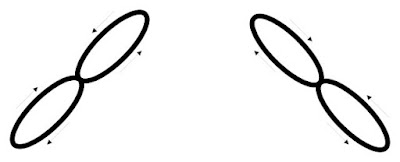First, it is squeezing the trigger while maintaining a good hold.
That brings the question, “What is a good hold?”
Simply put the hold depends on the person; their level of training—both in technical shot execution and physical traits like cardiovascular health; the position—prone, sitting, kneeling, offhand; weather conditions, such as wind, and even position of the moon and stars. The last may seem flippant, but some days we just can’t hold “normally.”
Taken in their entirety, the hold is defined by a wobble area, and the classic wobble area is shaped like a figure-eight on its side, or an infinity sign. The drawing below shows the classic wobble area. Depending on the person and position, the wobble area may look like the next drawing, or it could look more like an oval.

Classic wobble pattern.
Possible variations of wobble patterns.
The actual shape and size of the wobble is not important. What is important is that the center of YOUR wobble area be placed on the center of YOUR aiming point and the trigger squeezed.
With training your wobble area will become more consistent, and smaller. Additional training will also allow YOUR mind to shoot the shot in time with your wobble area.
Until then, it is not important to try to shoot at the center of the wobble. As long as the wobble area aligns with the center of YOUR aiming point YOU have a greater chance of hitting that aiming point, than trying to HIT the center. Essentially, your rifle muzzle is pointed at the center of your wobble area more than at the edges.
Here is a drill that you can do—if you want to improve your shooting:
You will need your UNLOADED hunting rifle, a pencil and paper and an aiming point on a wall. For safety you may wish to remove the bolt. For prone, sitting, kneeling and offhand positions make 5 to 10 holds on your aiming point. Pressing the trigger is not necessary. All you need to do is watch where your front sight—if using iron sights, or your crosshairs track. Watch it for 40 to 60 seconds on each hold, then put the rifle down and draw a representation of your wobble on the paper. When done compare the size and shape of your wobbles.
Competitive shooters sometimes perform this drill repeatedly. Elk Hunters can probably improve if they do it several times each year.
This posting illustrates the marriage of trigger control and the sights. Future posts will move to sights on The Elk Hunter’s Rifle. That is were the importance of a wobble area will become even clearer.
TTFN
Back to: My Initial Response





No comments:
Post a Comment